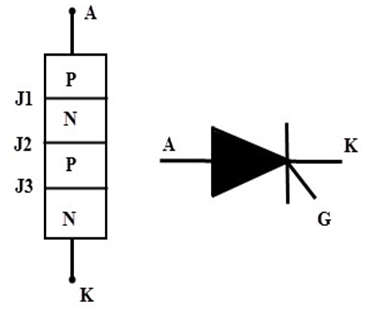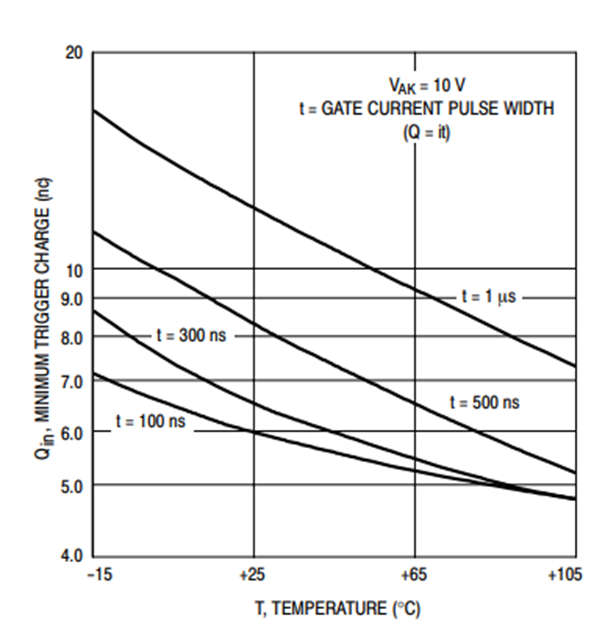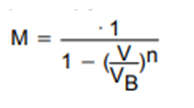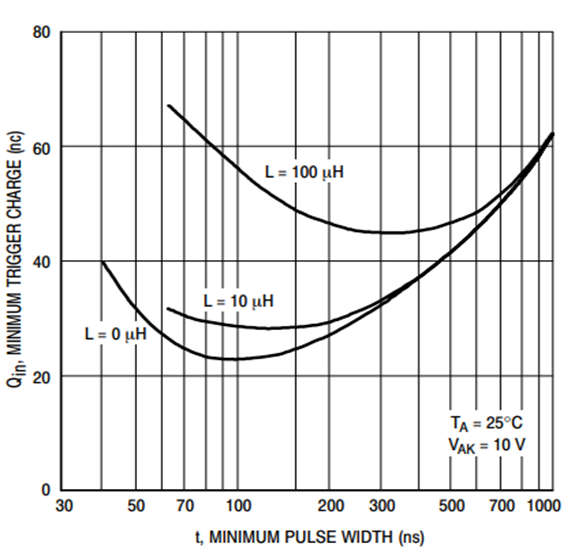- The term thyristor refers to a type of semiconductor device. Thyristor families are made up of many switching devices. A thyristor is a semiconductor solid-state power device. It consists of four alternating layers and three junctions J1, J2, and J3 of N-type and P-type semiconductor material. There are three terminals on a thyristor. Anode, cathode, and gate are the three components. When the anode of a thyristor is made positive concerning the cathode and a gate signal (between the gate terminal and the cathode terminal) is applied, it acts as a bistable switch and conducts.

What is SCR Triggering?
- Triggering is the process of turning on a device from its off state. Thyristor triggering is referred to as turning a thyristor ON. Thyristors are activated by increasing the anode current flowing through them. There are numerous methods for increasing anode current.
Voltage Thyristor Triggering:
- The applied forward voltage is gradually increased beyond a point known as the forward break over voltage VBO, while the gate remains open. This method is not preferred because it is associated with high voltage and current during thyristor activation, resulting in significant power loss and device damage.
Thermal Thyristor Triggering:
- When the temperature of the thyristor rises, the electron-hole pairs increase. This causes the leakage currents 1 and 2 to increase. The regenerative action tends to increase to units (1 + 2), and the thyristor may be activated. This type of turn-on is not preferred because it may result in thermal turn away, so it should be avoided.
Light Thyristor Triggering:
- These light rays are allowed to strike the thyristor junctions. As a result, the number of electron-hole pairs increases, and the thyristor can be turned on. This method is used to activate light-activated SCRs (LASER).
DV/DT Triggering:
- The charging current through the capacitive junction is high enough to turn on the thyristor if the rate of rising of the anode to cathode voltage is fast. A high charging current value can destroy the thyristor, so the device must be protected against high DV/DT.
Gate Triggering:
- This method of thyristor triggering is widely used due to its simplicity. C8 control over the thyristor gate triggering allows us to turn off the thyristor whenever we want. A gate signal is applied to the thyristor in this case. When a gate signal is applied to a forward biased thyristor, it will turn on. The gate loses control of the device once the thyristor begins to conduct, and the thyristor continues conduct. This is due to the regenerative action that occurs within the thyristor when the gate signal is applied.
Effect of Temperature
- As shown in the Figure below, the higher the temperature, the less charge is required to turn on the device. The lifetime of minority carriers increases with temperature in the temperature range where the SCR is operated; thus, less charge into the gate is lost in recombination.

- Charge is involved in gate triggering in three ways: (1) Qr, charge lost in recombination, (2) QDR, charge drained out through the built-in gate cathode shunt resistance, and (3) Qtr, net charge for triggering. They are all temperature sensitive. Because the temperature coefficient of voltage across a PN junction is small, QDR can be considered temperature invariant. At the operating temperature range, the temperature is too low to cause significant impurity gettering; however, lifetime increases with temperature, causing Qr to decrease with increasing temperature.
- Furthermore, Qtr decreases with increasing temperature because the T of the device in the blocking state increases with temperature at a constant current;7 in other words, to achieve T = 1 at an elevated temperature, less anode current, thus gate current [see equation (3) of Appendix I], is required; thus, Qtrb decreases. The input charge, which is equal to the sum of Qtr, Qr, and QDR, decreases as the temperature rises.
- With increasing temperature, the minimum current trigger charge decreases roughly exponentially. Actual data from an MCR729 deviates slightly from the exponential trend. At higher temperatures, the rate of decrease is slower; also, the rates of decrease of Qin vary; for large pulse widths, the recombination charge becomes more significant than for small pulse widths.
- As a result, as expected, and as shown in the figure above, Qin decreases more rapidly with the temperature at high pulse widths.
Effect of Blocking Voltage
- An SCR is an avalanche mode device; the device turns on due to carrier multiplication in the middle collector junction. The empirical equation provides the multiplication factor,

Where, - M = Multiplication factor
V = Voltage across the middle “collector’’ junction
(voltage at which the device is blocking before turn−on).
VB = Breakdown voltage of the middle “collector’’ junction
n = Some positive number - As V increases, M increases as well (the current amplification factor α = γδβM factor, and δ Factor of recombination). The greater the V, the greater the T. The minimum gate trigger charge would be expected to decrease as V increased. This effect is demonstrated by experimental results. The gate trigger charge of the MCR729 is only slightly affected by the voltage at which the device is blocking before turning on; this reflects the small exponent, n, in the above equation.
Effect of Gate Circuit
- As previously stated, the total amplification factor must be greater than unity for the device to turn on. This means that if some current is drained from the gate, causing the regeneration current to bleed, the turn-on will be affected. The lower the gate trigger charge, the higher the gate impedance. Because the regenerative current before turning on is small, the gate impedance only has a minor effect on the required minimum trigger charge; however, if the gate is overdriven to achieve a fast switching time, the gate circuit impedance will be noticeable.
Effect of Inductive Load
- The presence of an inductive load slows the change in anode current with time, causing the required charge for triggering to increase with inductance value. The inductive load has little effect on dc or long pulse width current triggering, but it has a significant effect on short pulse width current triggering, as shown in the Figure below. The charge rises because, at short pulse widths, the trigger signal is reduced to a negligible level before the anode current reaches a level sufficient to sustain turn-on.

